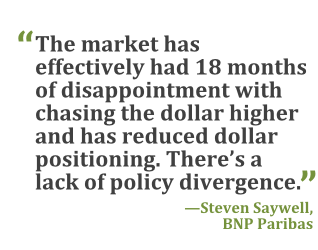Morgan Stanley said the dollar will suffer more losses as the greenback fell for a second day after the Federal Reserve refrained from tightening policy and lowered its long-term path for interest rates.
The U.S. currency weakened versus most of it major peers, pushing its drop this year beyond 4 percent, as traders digested the Fed announcement and the Bank of Japan's move to shift the focus of its stimulus to controlling interest rates. An index of 20 emerging-market currencies gained for a fourth straight day.
“The U.S. dollar decline has more weeks to go, we think about two months,” Hans Redeker, Morgan Stanley's chief global currency strategist in London, said in an interview with Bloomberg Television. “We suggest that the U.S. dollar will extend its decline, index-wise, between 4 percent to 5 percent.”
 The Fed's announcement further dims the outlook for the dollar after a 20 percent surge since the middle of 2014 gave way to weakness this year in the run-up to the decision. Currency traders are losing faith in the prospects of continued monetary-policy divergence with central banks in Europe and Japan.
The Fed's announcement further dims the outlook for the dollar after a 20 percent surge since the middle of 2014 gave way to weakness this year in the run-up to the decision. Currency traders are losing faith in the prospects of continued monetary-policy divergence with central banks in Europe and Japan.
Bloomberg's Dollar Spot Index, which measures the currency against major peers, dropped 0.3 percent as of 1:14 p.m. in New York, reaching the weakest level since Sept. 13. The greenback declined 0.3 percent to $1.1227 per euro and added 0.4 percent to 100.73 yen.
Dollar weakness opens up opportunities for the carry trade to borrow in the U.S. and invest in higher-yielding currencies, according to Redeker of Morgan Stanley, which is the world's 10th-largest currency trader according to Euromoney magazine. The Norwegian Krone jumped 1.9 percent, touching the strongest since May, and South Korea's won gained 1.5 percent.
“When you look at what does it mean for the high-yielding, emerging-market currencies, in some cases you can make gains up to 8 to 9 percent,” Redeker said.
The Fed's “dot plot,” which it uses to signal its outlook for the path of interest rates, shows that policy makers expect one quarter-point rate increase this year, followed by just two next year. Morgan Stanley expects no December hike this year, Redeker said in a Bloomberg Radio interview.
Regardless of when the Fed moves next, dollar bulls face the prospect of the slowest and shallowest tightening cycle in recent history, based on the market for overnight index swaps, which reflect expectations for the fed funds effective rate. The contracts imply the rate will rise to about 0.9 percent in three years from 0.38 percent now—essentially just two hikes during the next 36 months.
“The market has effectively had 18 months of disappointment with chasing the dollar higher and has reduced dollar positioning,” Steven Saywell, global head of foreign-exchange strategy at BNP Paribas SA, said at a briefing in New York. “There's a lack of policy divergence.”
© 2025 ALM Global, LLC, All Rights Reserved. Request academic re-use from www.copyright.com. All other uses, submit a request to [email protected]. For more information visit Asset & Logo Licensing.




